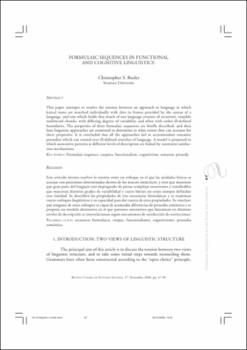Formulaic sequences in functional and cognitive linguistics
Author
Butler, ChristopherDate
2008Abstract
Este artículo intenta resolver la tensión entre un enfoque en el que las unidades léxicas se asocian con posiciones determinadas dentro de los marcos sintácticos, y otro que mantiene que gran parte del lenguaje está impregnado de piezas complejas recurrentes y reutilizables que muestran distintos grados de variabilidad y cuyos límites no están siempre definidos con claridad. Se describen las propiedades de tres secuencias formulaicas y se examinan cuatro enfoques lingüísticos y su capacidad para dar cuenta de estas propiedades. Se concluye
que ninguno de estos enfoques es capaz de acomodar diferencias de prosodia semántica y se propone un modelo alternativo en el que patrones asociativos que funcionan en distintos niveles de descripción se interrelacionan según mecanismos de satisfacción de restricciones. This paper attempts to resolve the tension between an approach to language in which
lexical items are matched individually with slots in frames provided by the syntax of a
language, and one which holds that much of our language consists of recurrent, reusable
multiword chunks, with differing degrees of variability, and often with rather ill-defined
boundaries. The properties of three formulaic sequences are briefly described, and then
four linguistic approaches are examined to determine to what extent they can account for
these properties. It is concluded that all the approaches fail to accommodate semantic
prosodies which can extend over ill-defined stretches of language. A model is proposed in
which associative patterns at different levels of description are linked by constraint satisfaction mechanisms.





